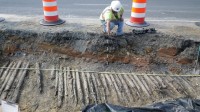A county construction crew in Fairfax County, Virginia, has unearthed a section of a rare Civil War-era cedar log highway. A crew from the Fairfax County Utilities Design and Construction Division (UDCD) was digging for a new road shoulder and sidewalk on Ox Road when workers found a layer of old macadam (a small stone aggregate road surface invented by John MacAdam in the 1820s). Beneath it was a line of cedar logs laid next to each other, a design known as a corduroy road because of its resemblance to the striated fabric. Ken Atkins, senior inspector for the UDCD and avid history buff, made sure the macadam stones were removed very carefully so as not to disturb the wood underneath.
 Atkins stopped excavation and alerted UDCD engineer Mohamed Kadasi who called the Fairfax County Park Authority’s Cultural Resource Management and Protection Branch (CRMPB). They sent archaeologists to assess the site who confirmed that Mr. Atkins’ instincts were spot-on. His cautious, thoughtful approach saved a very rare surviving historic Civil War road surface. Logs were a common road surface at the time, especially during the war when the constant tramping of Union and Confederate soldiers turned dirt roads into sucking mud pits.
Atkins stopped excavation and alerted UDCD engineer Mohamed Kadasi who called the Fairfax County Park Authority’s Cultural Resource Management and Protection Branch (CRMPB). They sent archaeologists to assess the site who confirmed that Mr. Atkins’ instincts were spot-on. His cautious, thoughtful approach saved a very rare surviving historic Civil War road surface. Logs were a common road surface at the time, especially during the war when the constant tramping of Union and Confederate soldiers turned dirt roads into sucking mud pits.
The CRMPB documented the site, taking photographs and planning a more thorough future recording of the historic road. When they were done for the day, Atkins covered the excavated trench with a steel plate to protect the cedar logs and keep members of the public from falling into the pit.
Then came the bureaucracy. While the county is using the land for public works, it actually belongs to the state of Virginia and is being worked under the aegis of an easement held by the Virginia Department of Transportation (VDOT). Therefore before a formal excavation of the cedar road could be done, the CRMPB needed a permit from the Virginia Department of Historic Resources. Usually that sort of thing can drag on for weeks, but everyone pulled together. Within 48 hours, the CRMPB had drawn up a work plan and submitted the permit application, the VDOT had agreed to the plan and signed the permit.
Armed with the permit, the CRMPB team used a total station, one of those surveyor’s tools that looks like a big yellow plastic camera on a tripod, to record the cedar log road in 3D. They also got a favor from the Fairfax County Geographic Information System (GIS) department which has been using high definition LiDAR data to create a detailed topographic map of the county. The CRMPB asked them to process the data from the area around the road find and it returned evidence of a Civil War circular fort that once protected the roadway.
CRMPB archaeologists recorded every log and its exact location, numbered them and then attached two tags with the assigned number to each end of the log. Then they cut through them. I know it sounds horrible and it is, but the UDCD had a drainage pipe to install, and the decision was made that it was better for historical accuracy and preservation to cut the logs but leave them in situ rather than pull them out. Once the pipe was in place, the trench was backfilled up to the cedar log road. The cut ends of the logs were put back in their original places and then the trench was backfilled again, this time up to the modern ground level.
While the road is now reburied and will likely remain so in perpetuity, thanks to the documentation and GIS data, the CRMPB hopes to digitally reconstruct the area as it was during the Civil War.
Jim Lewis, a member of the executive committee of the Bull Run Civil War Round Table, said a corduroy road from the Occoquan River to the Fairfax courthouse was a major pathway in the war.
The logs that the county workers found are almost certainly part of the first section of that road, from the courthouse to Fairfax Station, which was built in 1862, Lewis said. “Almost certainly” because Lewis pointed out that a specific dating process hasn’t been used to verify that the wood is from the Civil War and not from a later incarnation of Ox Road.
If the corduroy road does date to the Civil War, the historian said, it would have been traveled by Union Gen. Joseph Hooker, Confederate Gen. J.E.B. Stuart and other famous generals.
The road would have been a link to get supplies from the railroad at Fairfax Station to the Fairfax courthouse, a significant Union supply depot, he said.
Most other corduroy roads have long rotted away, Lewis said, which makes the Fairfax discovery substantial.
“To find a corduroy road intact is spectacular,” he said.